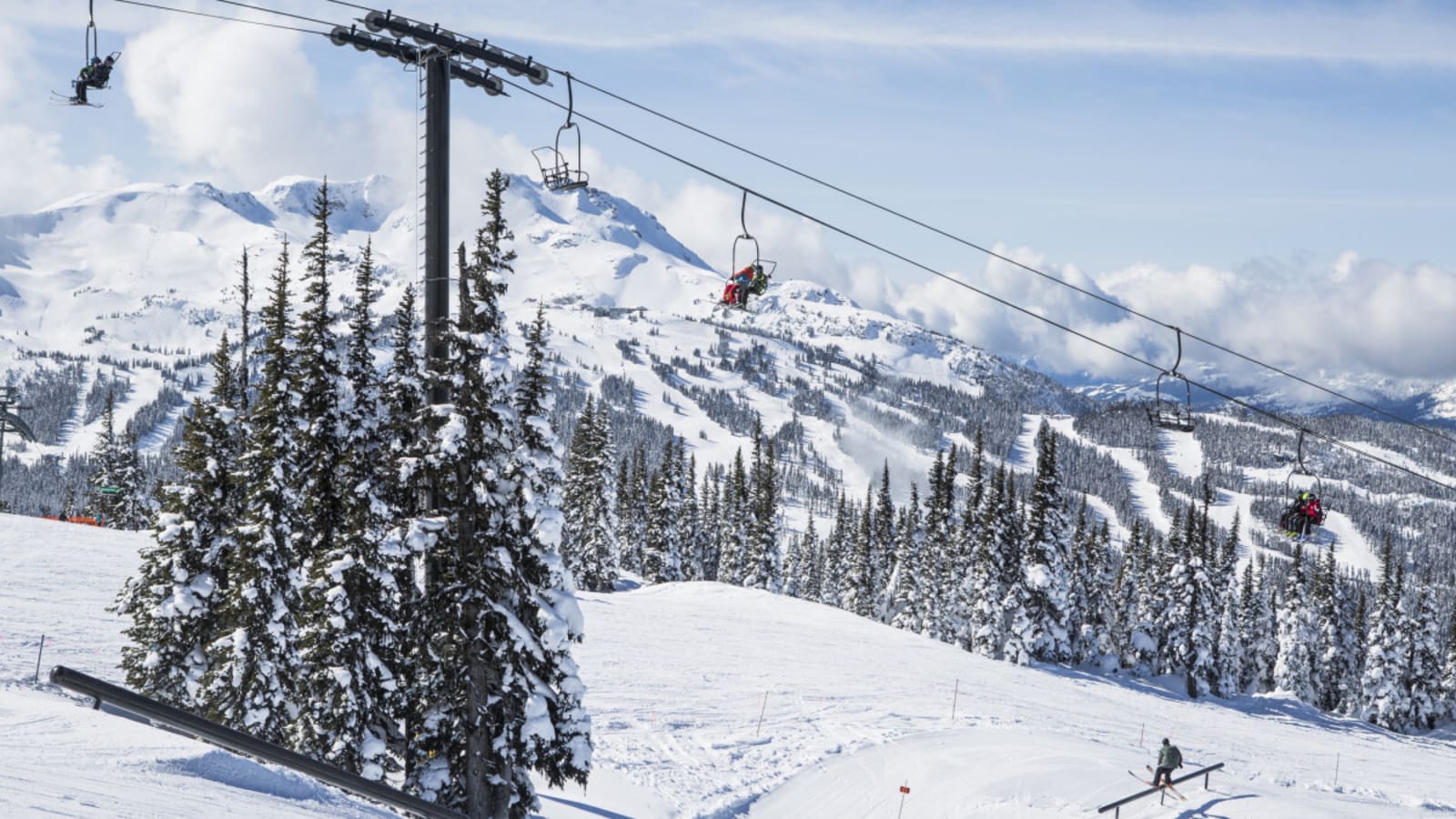
Skiers love big numbers. The largest vertical, the highest peak, the most annual average snowfall—superlatives, hate it or love it, make the ski industry go round.
What about the inverse of these records, though? Surprisingly, small and low is interesting, too, which is why we've compiled a list of some of the lowest ski areas in North America.
This list includes a mixture of low-altitude destination resorts and lesser-known ski areas that reside near sea level. For skiers, there's an obvious benefit of visiting these resorts—you won't need to worry about getting altitude sick.
Want to keep up with the best stories and photos in skiing? Subscribe to the new Powder To The People newsletter for weekly updates.
1. Cape Smokey, Nova Scotia
Cape Smokey is something of an oddity. Perched on the coast of the Atlantic Ocean, the ski area provides views of the seemingly endless, briny waves from Nova Scotia's Cape Breton Island.
Another quirk: Despite its humble footprint, which consists of 15 runs, the ski area features a gondola. This piece of lift infrastructure accesses a 1,050-foot summit. The base elevation, unsurprisingly, is nearly at sea level. For skiers with a nautical bent—and a penchant for avoiding crowds and the trappings of destination resorts—Cape Smokey could make for a unique trip.
2. Ski Ben Eoin, Nova Scotia
Founded in 1968 by a group of enthusiastic local skiers, the 33-acre Ski Ben Eoin, like Cape Smokey, is located in Nova Scotia. The ski area's base elevation is near sea level, and its summit is just over 500 feet, making it another of North America's lowest lift-served skiing locales.
Ski Ben Eoin offers night skiing and features a small collection of lifts, including a quad chair. Below the slopes is the briny Bras d'Or Lake, a UNESCO-designated biosphere popular amongst sailors. When they've finished a day on the slopes at Ski Ben Eoin, skiers and snowboarders can congregate in the ski area's Broken Buckle pub for eats and drinks.
3. Marble Mountain Resort, Newfoundland and Labrador
With a base elevation of 33 feet, altitude sickness isn't a risk at western Newfoundland's Marble Mountain Resort. The province-owned destination covers 230 acres of skiable terrain and has several notable bona fides, including Atlantic Canada's only high-speed detachable quad chairlift, 16 feet of average annual snowfall, and a ski run that travels three miles.
Marble Mountain's summit stands at 1,791 feet, establishing a solid vertical descent of roughly 1,700 feet
4. Yawgoo Valley, Rhode Island
Rhode Island does, in fact, have skiing—welcome to Yawgoo Valley. Once, a small collection of ski areas peppered the state. Now, only Yawgoo Valley remains. The ski area is predictably humble, with gentle, rolling slopes. When powder arrives, Yawgoo Valley prefers to groom all of its runs because, when they're covered in snow, they aren't steep enough for skiers to carry speed.
Rhode Island has hills—not mountains—a geographic fact reflected in Yawgoo Valley's 315-foot summit. The base area, meanwhile, stands at about 70 feet. That means visiting the ski area offers the opportunity to obtain a different kind of bragging right. You skied the highest mountain in the world? What about skiing in Rhode Island, almost at sea level?
5. Mark Arendz Provincial Ski Park, Prince Edward Island
The maritime province of Prince Edward Island is home to the Mark Arendz Provincial Ski Park. This homey little ski hill is the only place in PEI where you'll find lift-served alpine skiing. It features two lifts—a magic carpet and a quad chair—that service nine trails. The ski area was renamed in 2018 in honor of PEI local and Paralympic Nordic skiing medalist Mark Arendz.
Mark Arendz Provincial Ski Park first opened in 1967. Since then, it has expanded to include more terrain, now featuring three terrain parks, one tubing park, and 27 kilometers of groomed XC trails alongside its alpine footprint.
6. Whistler Blackcomb, British Columbia
Whistler Blackcomb, British Columbia, has it all. Massive vertical, a vibrant base village, challenging terrain—there's a reason this sprawling destination is considered one of North America's best. What Whistler Blackcomb doesn't have, though, is altitude. The mountain tops out at around 7,500 feet, meaning you can enjoy the alpine without the risk of altitude sickness.
Given Whistler Blackcomb's vast vertical—its base is only 2,214 feet above sea level—variable, sometimes wet weather is something to consider before making a trip. However, thanks to the resort's lift network that climbs high into British Columbia's peaks, it can be possible to find fresh snow even when rain is falling on the lower mountain.
7. Fernie Alpine Resort, British Columbia
Fernie Alpine Resort is a somewhat hidden gem perched along the famed Powder Highway, a network of snowy ski areas in British Columbia. The mountain serves varied, challenging terrain at relatively low elevations that don't exceed 7,000 feet. Heavy snowfall is another notable trait—each winter, on average, Fernie picks up 37 feet of the white stuff.
8. Alyeska Resort, Alaska
Alyeska, Alaska, is known for going big. The resort regularly gets more snow than any other resort in North America and sits within a confluence of challenging mountainous terrain. The town of Girdwood—where Alyeska is located—adds to the resort's legendary status. Here, several heliskiing outfits offer airborne trips into the surrounding mountains. In Alyeska and Girdwood, the spirit of extreme skiing is alive and well.
Yet, when it comes to altitude, Alyeska's surprisingly tame. The ski resort's base area sits at 250 feet, while the resort reaches no higher than 4,000 feet—that's lower than Denver, Colorado.
9. Revelstoke Mountain Resort, British Columbia
Similar to Alyeska, Revelstoke Mountain Resort, British Columbia, is a place of superlatives. The ski area features the continent's longest vertical descent, which clocks in at 5,620 feet. Tough terrain accessible from the Stoke Chair boosts the allure of Revelstoke Mountain Resort for extreme skiers, as does its sprawling 3,121 acreage.
If you don't like popping ibuprofen like Skittles, you'll be satisfied at this ski area, too, which, at its highest point, hovers around 7,500 feet. Due to Revelstoke Mountain Resort's significant vertical, though, you may want to do some squats in advance.
10. Schweitzer Mountain, Idaho
Schweitzer Mountain, Idaho, strikes a balance between the realms of destination resorts and laidback mom-and-pop ski areas. It's big, but not enormous, with ten lifts and 2,900 acres of skiable terrain. This acreage covers a range of trails catered to everyone from beginners to experts.
For the toughest skiing, consider visiting Outback Bowl, where the Colburn Triple cruises above several black diamond and double black diamond trails. At the resort's roughly 6,400-foot high points, you won't find yourself gasping for air. The same is true for Sandpoint, Idaho, where many Schweitzer visitors stay at an approachable 2,070 feet.
More must-reads:
- Former first-round pick gets traded for second time in two days
- Angel Reese continues hot streak with monster game against Mystics
- The 'MLB active strikeout leaders' quiz
Breaking News
Trending News
Customize Your Newsletter
 +
+
Get the latest news and rumors, customized to your favorite sports and teams. Emailed daily. Always free!








